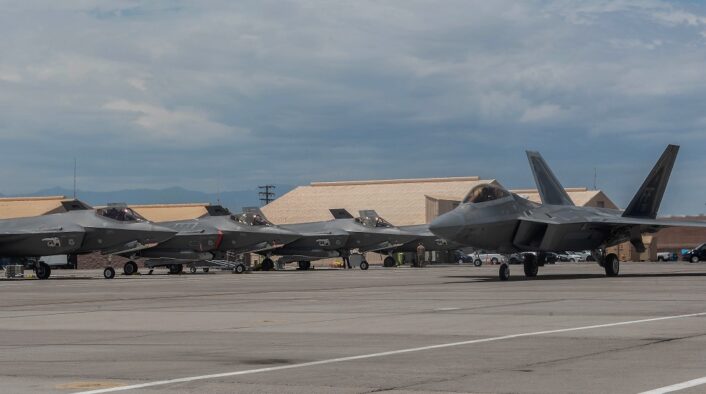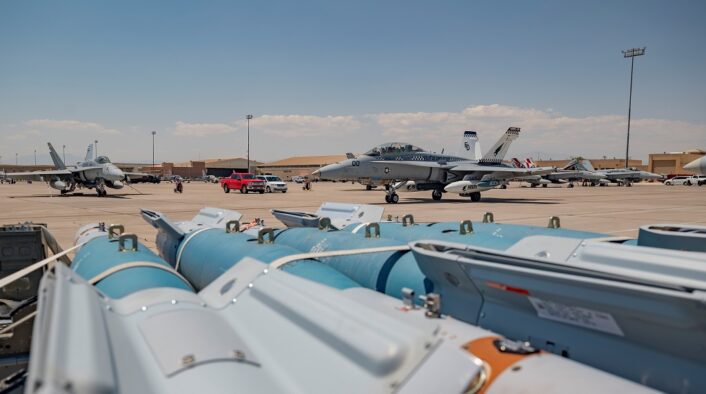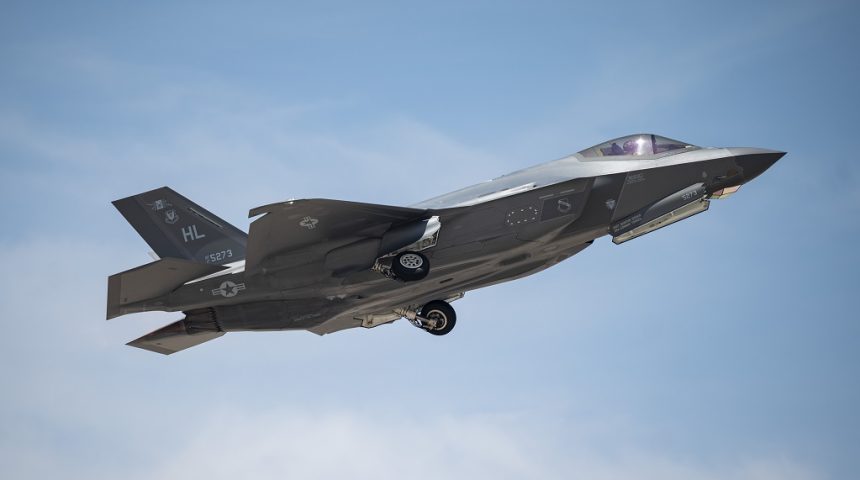Red Flag 21-3 saw the participation of all services from the U.S. Armed Forces to train next generation joint warfighting against more modern, stronger and dangerous threats, including Aggressor F-35s.
Blue air participants of Red Flag 21-3 found themselves fighting for the first time against F-35 Lightning II aggressor pilots, in one of the most complex exercises ever held at Nellis Air Force Base (Nevada) which included every domain of the modern warfighting. Red Flag exercises have been around for 46 years to tactically train fighter pilots but, as the threats posed by potential adversaries evolve, time has come for the exercise to evolve to its next generation.
“I have air-to-air aggressors. I have surface-to-air aggressors. I have space and information aggressors. The aggressor is the person who’s here to train blue by providing a realistic and robust adversary that they, being blue, have to actively fight against. They have to use every bit of the capabilities that they have and every bit of integration that they can compile to achieve what their intent is for that day”, said Col. Scott Mills, commander of the 57th Operations Group and an F-35 aggressor pilot. “Knowing what I know about those blue air capabilities and the blue air integration, my job is to pick that apart, to pull at the seams,” he continued. “The aggressor nation here is one of the best in the world at finding those niches, finding those gaps and seams, and absolutely punishing those mistakes that blue air makes.”
Lt. Col. Chris Finkenstadt, commander of the 64th Aggressor Squadron, said in the press release that Aggressor F-35s are being introduced during this Red Flag to expand upon the F-16 aggressors’ threat capabilities, so the exercise’s scenario more accurately represents advanced enemy fighters. It should be noted that F-35s already took the adversary role during past Red Flags, but the important difference here is that this time the 5th gen aircraft are operated by 64th Aggressor Squadron pilots, which are specialized in the threat replication thanks to their lengthy certification process where they gain a comprehensive understanding of U.S. adversaries and their tactics.
“What aggressors are able to present to them is a more challenging problem for blue air assault,” said Lt. Col. Finkenstadt. “The aggressors know the threat replication a little bit better, and they have studied the adversary and the way that the adversary would actually react to a specific situation. Based on our focus toward great power competition, we need to make sure that those guys are ready, and we do that by presenting the best possible atmosphere we can.”
The role of the F-35 as Aggressor during Red Flag is important as it will showcase what blue forces can do against low-observable type threats similar to what potential adversaries are developing, like the Russian Su-57 Felon and Su-75 Checkmate and the Chinese J-20 Mighty Dragon and FC-31 Gyrfalcon. The pilots of 4th gen aircraft might be at a disadvantage against those threats, so the F-35’s new Aggressor role should help to develop the tactics that will help pilots to fight and win against 5th gen threats.
“At the end of the day, my job is not to give blue an easy day. My job is to give blue the absolute toughest day that I can. And the way for me to do that is to bring the F-35 into the fight. And the F-35 is going to make it exceptionally difficult for blue to achieve their objectives. They’re going to need to take every bit of capability they have, every bit of integration they can, to achieve their intent,” said Col. Mills.

Air Force officials did not provide precise info about the performance of the F-35 during the simulated engagements however, even if they did, those numbers would not make much sense as they are strictly dependent on the actual Rules Of Engagement (ROE) and the training scenario. In fact, the scenario and ROE might even put the fighters in situations that would never happen in a real engagement, just for the training value to have pilots ready for anything and prepared for the worst-case scenario.
“The first two days, blue’s nose gets pretty bloodied. And then by the end of week one, you start to see their lessons learned are getting passed around and they’re starting to figure things out a little bit,” said Lt. Col. Finkenstadt. “Then, day one or two of week two, they may get their nose bloodied again, because we tend to ramp it up a little bit. It usually takes a couple of days to start figuring out different game plans and how they want to package their forces to solve their problems.”
During exercises like Red Flag, the de-brief after each mission is invaluable and maybe even more important than the mission itself, as pilots and crews will go all over their flight planning again, taking a look at how they reacted, what the threat was, what they didn’t see and what they didn’t do. At the same time, the debriefing is where the new lessons learned will help figure out how to best combine everyone’s capability so the joint effort can successfully reach the mission objectives.
“We see walls come down between communities. We see stovepipes disappear. We see teams that have never before worked together, not only working together, but truly integrating their capabilities to achieve an end result. And I’ll tell you when blue air does that, it’s exceptionally difficult for red air to pull that game plan apart,” said Col. Mills. “At the end of the day, the truth is that no one of us, no one capability is outstanding or the best in the world. Our outstanding capability comes from the fact that we work together well through exercises like this. We operate across our joint and coalition partners to form one truly unstoppable blue force.”
And here we reached the second focal point of the latest Red Flag exercise, the joint forces. Red Flag-Nellis 21-3 involved only U.S. personnel, allowing the joint participants from other services and major commands to focus on details and sharpen their skillsets at a high classification and high tactical level against a stronger, more dangerous threat. Alongside the Air Force, the exercise included the Navy, Marine Corps, Space Force, Air National Guard and the Air Force Reserves, with more than 100 airframes, including 40 5th generation aircraft.
“When you can bring joint units along with the Air Force in an environment like this, it’s no longer part-task training,” said Lt. Col. Tyler Stef, Red Flag commander. “It is full integration… We will better know and understand their service culture. Red Flag is the opportunity people get to come and start to build those relationships that will ultimately last a career.”
Lt. Col. Stef said that Red Flag 21-3 was focused on a Pacific region threat, an area where the great power competition continues to bring the tensions between China and the USA higher and higher. As mentioned in the press release, Red Flag is another way to prepare and allow participants to experience situations similar to those possible in the real-world, so the Pacific Air Forces brought to the exercise their insight about the different problem sets and unique perspectives of the Pacific region.
“Joint interoperability is important,” said U.S. Marine Corps Lt. Col. Tim Miller, VMFA-115 Marine Fighting Squadron commanding officer. “It allows us to practice how we are going to operate in the event that some real-world combat operation was to arise. That’s kind of where the Department of Defense is focusing now, which has put some additional emphasis on exercises such as Red Flag. It’s all about integration, and we’re still able to get that done in an extremely professional environment. For our maintainers to understand how the airfield operates and functions is a huge combat readiness enabler for us”.

However, while everyone is working to build the joint warfighting machine, someone has to give them some obstacles to face. While the 64th AGRS provides cutting-edge air-to-air threats, the 414th Combat Training Squadron makes air-to-ground employment more challenging with complex target areas, camouflage and concealment techniques across multiple spectrums and advanced surface-to-air threats.
Red Flag, in fact, unleashes the aggressor nation as they refine threat replication, apply advanced jamming and increase threat capabilities to maximize training in non-permissive environments. “Red Flag’s goal is to challenge, disrupt and if able, deny our communication and interoperability,” said Lt. Col. Evan Parr, 27th Fighter Squadron director of operations. “They force errors and punish mistakes. We get better by working through these problems in the air and as we debrief each fight.”
Another novelty of Red Flag 21-3 is the integration of space components into both blue and red forces. “As non-kinetics and Space itself, we’ve already infused with Global Positioning Systems, satellite communications (SATCOM) and bringing what we offer at Red Flag on the electronic warfare side,” said 2nd Lt. Joshua Miller, 16th Space Control Squadron. Miller explained that electronic attack and electronic surveillance assets provide an option to help monitor and detect Electromagnetic Interference (EMI) for the blue forces’ signals and its health, while also allowing to do the same against the red force’s EMIs.
The 414th CTS planned a multitude of joint space assets and tools to rival both red and blue forces during the exercise. “Without space-based capabilities, you lose access to GPS satellites, around the world communication, SATCOM, along with convenience,” said Maj. Paul Sula, 26th Space Aggressor Squadron standards and evaluation flight commander. “I believe there is a role to play, and space is a fantastic enabler.”
Meanwhile, this seems to be just the first of many renewed Red Flags, as the Air Force is planning to make more space at Nellis AFB for 5th gen fighters. The 4th generation A-10 and HH-60 squadrons will move from Nellis AFB to Davis-Monthan AFB (Arizona), starting in fiscal year 2022 and freeing additional range capacity necessary to test and train warfighters in 5th-generation aircraft.
“Our nation and joint force commanders depend on us to control and exploit the air. To do that, we need the additional range and aircraft maintenance infrastructure capacity at Nellis to fully test and train with our most advanced capabilities,” said Gen. Mark Kelly, commander of Air Combat Command. “Our rescue squadrons will continue to train and hone their critical skills in support of operational missions from their new location.”
The move however will also allow personnel recovery units to take advantage of the synergy provided by collocating with other rescue units, as Davis-Monthan AFB already hosts HH-60s and HC-130s, in addition to A-10C squadrons. The A-10 Weapons Instructor Course and Test and Evaluation operations will transition to Davis-Monthan AFB in 2022. The HH-60 WIC, Test and combat coded units to include the 88th Test and Evaluation Squadron, 66th Rescue Squadron, 58th Rescue Squadron, the 34th Weapons Squadron and the 855th Aircraft Maintenance Squadron will move beginning in 2024.
By the way, the Air Force is planning to modernize and maintain only 218 of the current fleet of 281 combat-capable A-10s, according to Lt. Gen. David Nahom, Plans and Programs deputy chief of staff. Among the aircraft affected by the cuts there are 35 A-10C already based at Davis-Monthan AFB. The decision however is not final, as the retirement of the first 42 A-10s is subject to congressional approval.
“Under this plan, Davis-Monthan will play a critical role in reshaping U.S. airpower as home to the Air Force’s close air support and rescue Centers of Excellence,” said then Acting Secretary of the Air Force John P. Roth. “This realignment will consolidate all A-10 and HH-60 test, training, and weapon school activity at one location, allowing Airmen in these mission areas to train together for future threats.”
With these changes, the Air Force plans to transform Nellis AFB in a 5th Generation Center of Excellence. The base is currently on track to receive more F-35s to support F-35 operational test requirements and additional F-35As from Eglin AFB (Florida), as part of the reactivation of the 65th Aggressor Squadron, and additional F-22s for testing from Tyndall AFB (Florida), as well as further improving the Nevada Test and Training Range to train 5th generation systems in a live environment.
As we already reported here at The Aviationist, the Air Force has been working for a couple of years already to reactivate the 65th Aggressor Squadron. The unit will receive about a dozen early production non-combat capable 5th generation aircraft by 2022 (with the first possibly later this year) as Eglin AFB receive newly produced aircraft to replace them. While during Red Flag 21-3 the F-35s flown by the 64th AGRS pilots were in the standard USAF livery, the 57th Wing confirmed that a threat representative color scheme will be used on some of the Aggressor F-35s.









